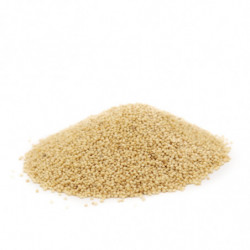- Out-of-Stock


Amaranth has a mild and earthy flavor, with a slightly crunchy texture when cooked properly. It can be used in soups, stews, salads, as a filling for vegetables, and can be mashed or baked into cookies. It can also be used to make flour and can be used as a substitute for wheat flour in bread and other baked goods. Additionally, amaranth leaves are edible and can be used as greens in salads and cooked dishes.
 Security policy
Security policy
Website built using newest versions, SSL protocols, Secure payments
 Delivery policy
Delivery policy
Receive your order in 24-48h
 Return policy
Return policy
100% Satisfaction guarantee

Guarantee safe & secure checkout
Amaranth originates from Central and South America and has been cultivated for over 8,000 years. Ancient Aztecs and other pre-Columbian peoples revered it as a sacred plant, using it both as food and in religious ceremonies. Unfortunately, during the Spanish conquest of the Americas, the conquistadors banned its cultivation and consumption, considering it a pagan plant associated with indigenous religious practices. However, fortunately, the plant was never completely extinguished and is still cultivated and consumed in many parts of the world.
Amaranth is an annual plant belonging to the Amaranthaceae family, which includes over 60 genera and 900 species. There are several varieties of amaranth, among the most well-known are common amaranth (Amaranthus retroflexus), leaf amaranth (Amaranthus hybridus), red amaranth (Amaranthus cruentus), and white amaranth (Amaranthus albus). It is a resilient plant that adapts well to a wide range of growing conditions, making it attractive for sustainable agriculture.
Amaranth is a rich source of protein, fiber, and nutrients, making it a nutritious and beneficial food. It contains a high amount of lysine, an essential amino acid found in limited quantities in other grains. It is also rich in iron, calcium, magnesium, and B vitamins. Additionally, amaranth contains antioxidants and anti-inflammatory compounds that can help reduce the risk of chronic diseases such as heart disease, diabetes, and cancer, as well as antidiabetic properties that can help control blood sugar levels.
Amaranth can be used both as a grain and in fresh leaf form in a wide variety of dishes. Amaranth grains can be cooked like rice, added to soups and stews, or ground into flour to make bread and cakes. They can also be popped like popcorn to make a healthy and tasty snack. Amaranth is highly versatile in the kitchen and can be used in the form of seeds, flour, or oil. Its mild, slightly sweet flavor and crispy or fluffy texture make it ideal for salads, soups, stews, creams, breads, cookies, pancakes, energy bars, and drinks.
I propose a simple and delicious recipe with amaranth: amaranth and chocolate cookies. Here are the ingredients you need:
And here are the steps to follow: